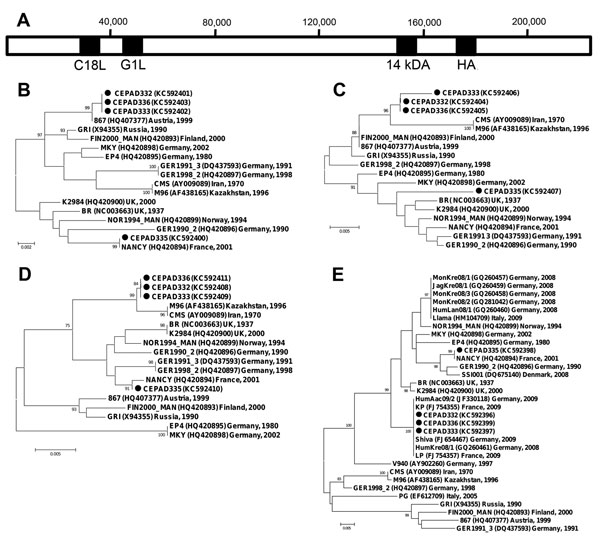Concomitant Human Infections with 2 Cowpox Virus Strains in Related Cases, France, 2011
Corinne Ducournau, Audrey Ferrier-Rembert, Olivier Ferraris, Aurélie Joffre, Anne-Laure Favier, Olivier Flusin, Dieter Van Cauteren, Kaci Kecir, Brigitte Auburtin, Serge Védy, Maël Bessaud, and Christophe N. Peyrefitte

Author affiliations: French Army Biomedical Research Institut, Grenoble and Lyon, France (C. Ducournau, A. Ferrier-Rembert, O. Ferraris, A. Joffre, A.-L. Favier, O. Flusin, C.N. Peyrefitte); National Reference Center for Orthopoxviruses, Grenoble (C. Ducournau, O. Ferraris, C.N. Peyrefitte); French Institute for Public Health Surveillance, Lyon (D. Van Cauteren); Regional Hospital of Epinal, Epinal, France (K. Kecir, B. Auburtin); Legouest Military Hospital, Metz, France (S. Védy); UMR190 Aix Marseille University EHESP French School of Public Health, Marseille, France (M. Bessaud)
Main Article
Figure 2

Figure 2. . Schematic representation of cowpox virus (CPXV) GRI genome (A) and phylogenetic relationships between 4 genomic regions of CPXV isolates collected in France during 2011 and other CPXVs: C18L (B), 14-kDa (C), G1L (D), hemagglutinin (E). The sequenced regions are shaded in black in panel A. Nucleotide sequences were aligned by using CLC Main Workbench 6.0 software (CLC Bio,Aarhus, Denmark). Neighbor-joining phylograms were constructed in MEGA4 (www.megasoftware.net) by using the maximum composite likelihood method; the robustness of the resulting trees was assessed with 1,000 bootstrap replicates. The length of the branches is proportional to the number of base substitutions per site. The percentage bootstrap values are indicated if >70. Circles indicate the 2011 isolates from France; for other isolates, the year and country of isolation are indicated. Scale bars indicate nucleotide substitutions per site.
Main Article
Page created: November 19, 2013
Page updated: November 19, 2013
Page reviewed: November 19, 2013
The conclusions, findings, and opinions expressed by authors contributing to this journal do not necessarily reflect the official position of the U.S. Department of Health and Human Services, the Public Health Service, the Centers for Disease Control and Prevention, or the authors' affiliated institutions. Use of trade names is for identification only and does not imply endorsement by any of the groups named above.
